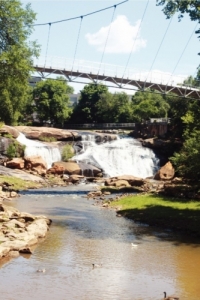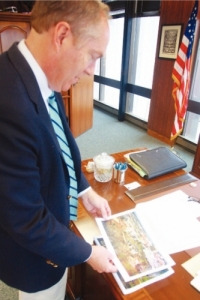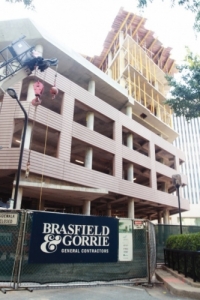Waterfall of potential
By Ty Johnson
Published in News on June 6, 2012 1:46 PM

News-Argus/TY JOHNSON
The Liberty Bridge stretches across the Falls at Reedy River Park. The bridge and park were part of a controversial $13 million investment by the city of Greenville in the early 2000s. After the park's completion, the city experienced a boom in development on its West End.

Greenville Mayor Knox White looks through photos from throughout downtown Greenville's history. Since his first election in 1995, he has overseen several projects that focused on the city's downtown revitalization efforts.

Development continues in downtown Greenville, here with the multimillion-dollar ONE Greenville project which will be a mixed-use tower of retail and office space featuring a corporate bank headquarters and an Anthropologie. The building, which will grow between the Peace Center for the Performing Arts and the Hyatt Hotel, will be yet another anchor for the city's Main Street.
GREENVILLE, S.C. -- Looking out from the 10th floor of Greenville's City Hall toward Greenville's West End, Mayor Knox White can remember when the citizens of his city couldn't see the waterfall.
He had, though, of course.
In the late 1990s, he had the city distribute a photo of it from the turn of the 20th century showing the Reedy River waterfalls in all of their glory.
On the other side of the card was what citizens saw then: the concrete columns of the Camperdown Bridge bearing indisputable testimony to Greenville's growth as the biggest city between Charlotte and Atlanta.
Those who drove across it could see the waterfalls, sure, but only at their own peril when they glanced away from the road and down into the ravine.
The card, which sought to sway public opinion concerning the proposed closing of the bridge, quoted a book of Greenville's history that claimed visiting the Falls was once one of the city's most popular recreational destinations.
"We can make Reedy River Falls the pride of our community once again," the card credits White with saying.
White today calls the Camperdown campaign and subsequent controversy his darkest time as mayor during his 17 years of leading Greenville.
It came to be known as City Hall's money-wasting campaign to close a "perfectly good bridge," but White was undeterred -- the citizens who opposed it hadn't seen the waterfall like he had, and so they didn't see the baseball stadium, high rise apartments and restaurants that would accompany it either.
*
Greenville's downtown today is a long road filled with restaurants, bars, clubs, stores and even South Carolina's only legal distillery, but longtime residents and merchants will tell you it wasn't always like that.
Looking up from the street's posh sidewalks and trendy shops, it's hard to believe them when they say Greenville's downtown was once a slum -- that its West End was deserted and its main street was filled with vacant lots and storefronts.
It began, White says, with a hotel.
But it wasn't enough that there was space for Hyatt to bring a hotel to the area in 1982. The city had to sweeten the deal in its first of many public-private partnerships.
Back then, White says, the city's decision to take its four-lane road and reduce it to two in an effort to make Greenville more pedestrian-friendly was quite unusual. The term "streetscape" didn't exist in the early 1980s.
Greenville's downtown had been suffering from the same symptoms as most across the country, he said. Malls and suburban sprawl were stretching downtown's relevance thin and there was hardly anyone left on Main Street when the city decided to build the hotel a parking deck and small plaza to entice it to the city center. Greenville even chipped in to put in a small convention center, although much of the funding came from federal grants that simply don't exist anymore.
Still, it worked.
Hyatt obliged and became downtown's new anchor, although it wasn't a silver bullet. Downtown needed another shot in the arm.
The Peace family came together in 1985 to kick off a $10 million fundraising drive to create The Peace Center for the Performing Arts at the corner of Main and Broad streets five blocks south of the Hyatt on what was once essentially an industrial park.
Confederate wagons were once produced in one of the factories, near a Duke's Mayonnaise factory and a textile plant. All but the textile plant were incorporated into the arts center, which grew again in 1989 when another benefactor pledged $3 million for the 400-seat Gunter Theatre. Three years later the center managed to reach its goal of $6,500,000 for an endowment to ensure continued operations. That total was raised in less than two years.
The arts proved to be a great investment for the city, as today public art lines Main Street where tourists pose for photos and locals sit for spells, but between the Peace Center and the Hyatt there was a wide chasm of underdeveloped real estate.
The city decided it was time to get involved.
*
Downtown development in Greenville is just one portion of the city's economic development department, which includes staff members dedicated to specific corridors of the area as well as the planning and inspections departments.
That structure allowed the city to get involved in advised investments, once more utilizing private-public partnerships.
Between incentives and investments, White said, the city simply just asked whether a move would truly work or not as it moved into the mid-1990s with an aggressive downtown revitalization plan of reaching out to businesses and finding ways to get them into town.
That's where Nancy Whitworth came in.
"We always ask 'How does it further what we do,'" said Mrs. Whitworth, who has been in the city's economic development department for 30 years.
Today she is the department's director, as well as Greenville's assistant city manager.
Greenville already benefited from major industry in its outskirts -- a private sector safety net that allowed for more risks, she said -- and a handful of colleges, including Furman University, but Mrs. Whitworth's job has been to keep the momentum, and it appears to be working.
"It's almost like being in a different city every five years," she said. "You can see (the growth) before your own eyes."
But getting things moving was a bit difficult in the beginning.
"It doesn't catch fire overnight," Mrs. Whitworth said, alluding to a nearly 20-year gap in the city's development when the city was working on its downtown but seeing very little return.
That's when it comes down to leadership, she said.
"You have to have leadership that's going to keep at it," she said, especially as the beginner's luck fades and the process becomes a waiting game as the pieces align.
Luckily, she said, White and the Greenville City Council were content with staying the course.
Her department has sought to focus on development from a business perspective, but at times used gimmicks and events to promote downtown, she said, as it sought to find the right balance.
A focus on young people -- and baby boomers who choose to continue to act young -- seemed to be the most beneficial model, she said.
Way-finding signage was another small way to help downtown merchants.
"Businesses appreciate it," she said. "It's the details that make the difference -- the execution of small things."
Sometimes that has meant plugging holes as they occur and keeping in touch with businesses after they have established themselves.
"It's like we were bringing in people by the front door and losing others out the back door," she said of two years ago when the city's focus to attract new investment allowed existing businesses to slip out.
Her department partnered with the county's economic development team as well as the local chamber of commerce to fill them, while also turning toward keeping downtown's businesses in downtown.
That type of cooperation among public officials, departments and private entities is what has kept the city thriving, Debra Agnew says.
And her business has been around long enough for her to know.
*
Ayers Leather has been on Main Street for 61 years and Mrs. Agnew is the third generation to run it.
She has seen downtown wane and wax with the times, but said the handful of businesses in and around Greenville -- Michelin, BMW and Lockheed to name a few -- have assured that no one entity is calling the shots. The lack of one business or movement dictating what happens has allowed businesses to grow organically in what she described as a domino effect.
"You've got to have a city that will allow people to dream," she says. "It never is as easy as people think, even when it's a success," Mrs. Agnew said.
Instead of cornering markets and helping only themselves, she said the Greenville elite have developed organizations to benefit the community at large.
That's the private sector safety net Mrs. Whitworth said the city depends on when it takes chances -- like closing perfectly good bridges.
*
It was a gigantic expenditure -- $4.5 million out of a tourism coffer -- and the city was simply asking its citizens to trust its judgment when Green-ville replaced the Camperdown Bridge with a pedestrian walkway known as the Liberty Bridge.
A total of $13 million was spent on the project, including the park beneath it, which exposed the Falls of Reedy River Park that White had always known was lurking beneath the Camperdown Bridge like an artist who sees the sculpture in his stone block.
No one knew it would be such an economic boost to the area, White admits, as restaurants grew quickly on the west side of the park -- now known as the West End -- leading to condominiums and Fleur Field, the home of the Boston Red Sox' class A affiliate which is a near-identical replica of Fenway Park right down to its own Green Monster in left field.
Aaron Arnett of Arnett, Muldow & Associates, an urban planning firm in Greenville that did much of the work on the city's West End, said that even fiscally conservative minds in the city view the government's choices differently.
"Most of that base sees the wisdom of investment," he said.
White said even the whispers of dissent have died out.
"You used to still hear the faint echoes of naysayers asking "Why are you wasting time downtown," he said. "That kind of talk doesn't happen in Greenville anymore. People love downtown. They're proud of downtown."
*
Today a Courtyard Marriott sits on a plot of land that was once owned by the city.
The city didn't give the land to the hotel, nor did it have to make many concessions or offer incentives to get the hotel to come downtown.
After three decades of incentives and investments since the city first lured the Hyatt downtown, Greenville's downtown has itself become the incentive.
The city that may as well have invented the term streetscape has continued to pioneer development ideas and seen its share of dissent in its 30 years of revitalization efforts. It never found the silver bullet that saved its downtown, but it pieced its way through.
And now everyone can see the waterfall.
